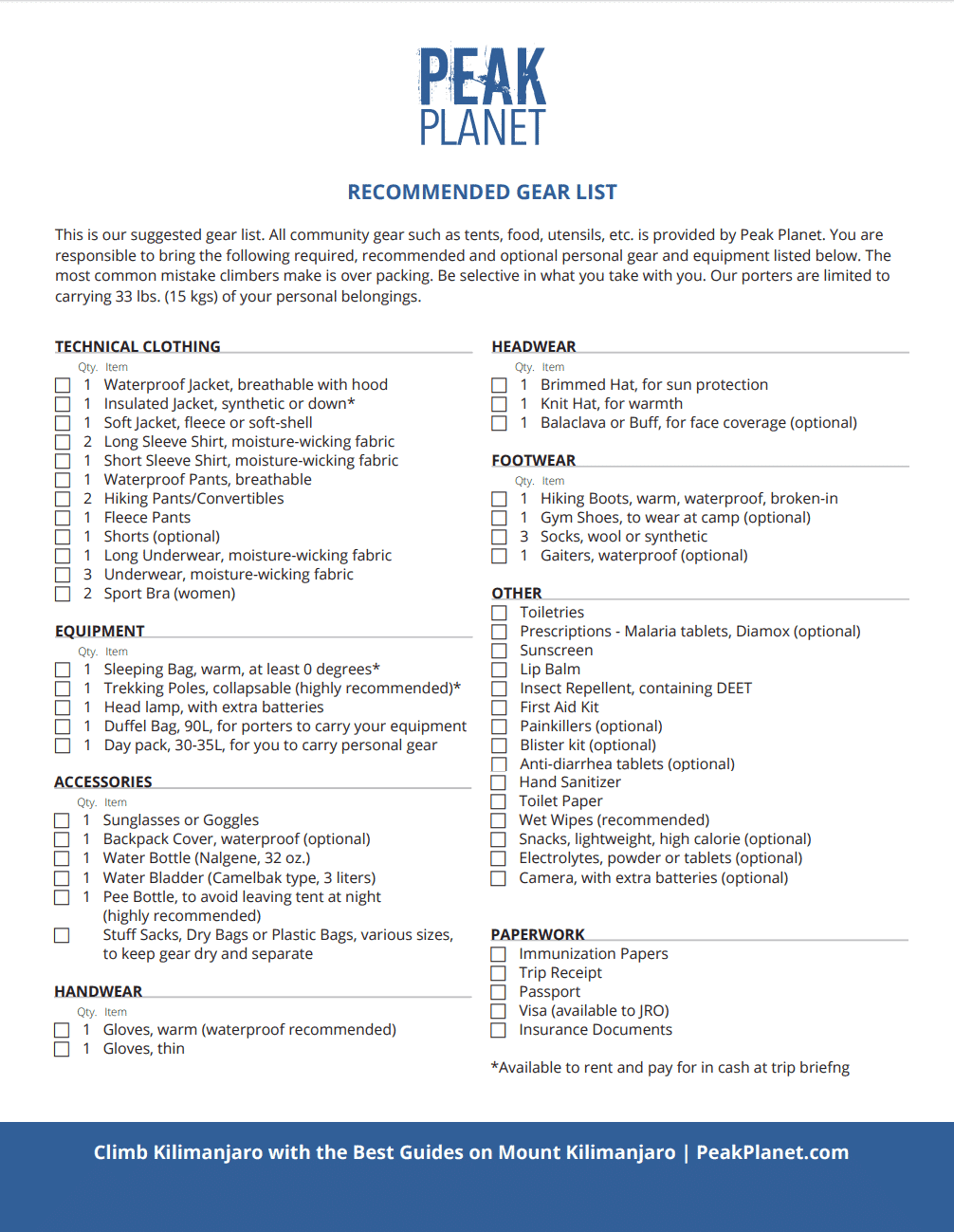One question climbers often ask is, “How do I dress on Mount Kilimanjaro?”
First, before we explain what clothing you will need, you should understand the weather conditions you may experience.
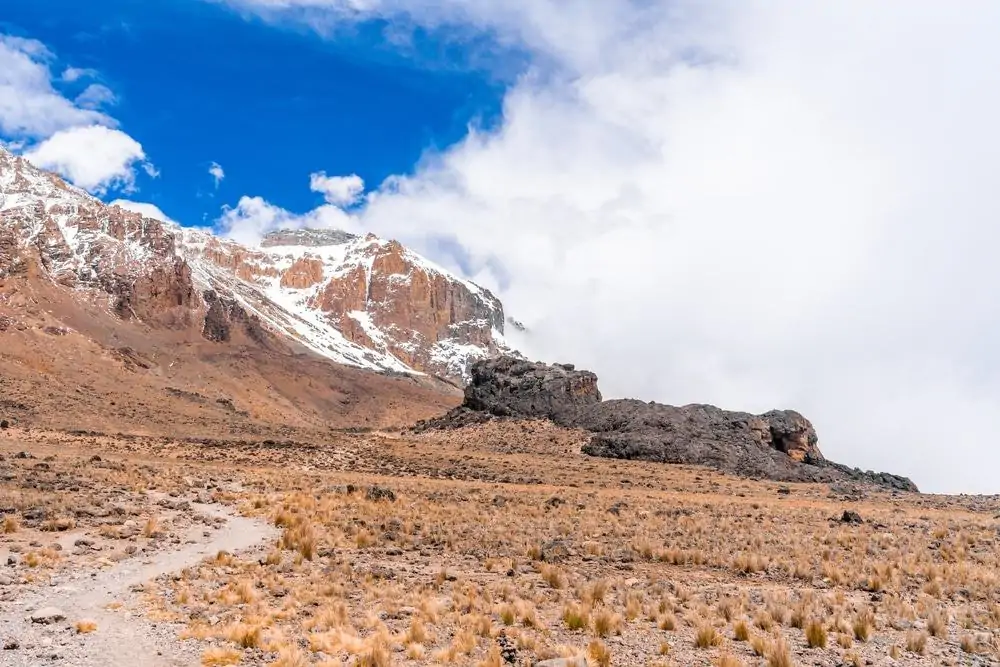
There are five distinct climate zones on Mount Kilimanjaro. Your trip starts low, in the warm cultivation zone. The trailhead is located in the humid rainforest. As you ascend, the trek continues in a mostly arid heather/moorland zone. Above that, is the alpine desert zone, which can be warm during the day, but very cold at night. And finally, the summit lies in the cold, windy arctic zone.
Each zone gets increasingly drier, colder, and windier as you climb higher. The sun also becomes stronger. Therefore, what you wear to climb Kilimanjaro must be able to protect you from the harsh environment from start to finish.
Below are Peak Planet’s recommendations for how to dress to accommodate these varying degrees of weather and temperatures.
Warmth and Comfort Through Layering
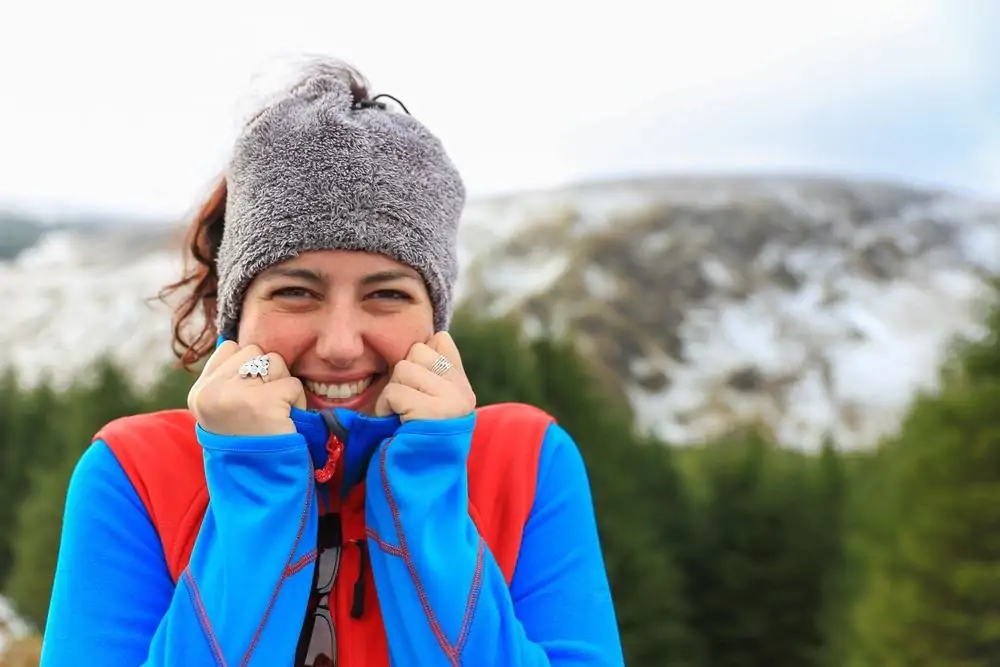
The best way of regulating your core temperature is by using layers of clothing. At the most basic level, the layering system consists of three different layers. Each serves its own purpose. These layers include a base layer, mid layer, and outer layer.
Base Layer
A base layer is worn against the skin. The main purpose is to transport or “wick” moisture off your skin and move it toward the surface of the fabric where it can evaporate. If your base layer holds moisture, you’ll quickly start to feel cold when you slow down or stop for a rest.
Base layers can be constructed of various textiles, such as synthetic materials, merino wool, or a blend. Each material has its own benefits and drawbacks. Synthetic base layers wick sweat more efficiently than other fabrics, but tend to hold odor. Wool naturally fights bacteria, but is usually more expensive and less durable. Experiment to find what is best for you.
The base layer should be either standard fit or close fitting, but never loose. By laying close to or on bare skin, it absorbs moisture and draws it away from the skin to the outer fibers of the garment, where it can evaporate. Make sure you are comfortable in your base layer as you are going to spend many hours in them.
Mid Layer
The mid layer adds insulation, traps body heat to keep you warm, and continues moving moisture outward. Down jackets, synthetic insulated jackets, and fleece jackets are all considered mid layers. Like a base layer, a mid-layer should be breathable and able to retain heat.
Fleeces are available in different thicknesses and are quick-drying and breathable, offering warmth by retaining heat and removing moisture. Down insulated jackets are packable with an excellent warmth-to-weight ratio, whereas synthetic insulated jackets are able to retain heat even when wet.
For Kilimanjaro, we include both an insulated jacket and a fleece jacket in the gear list. On the coldest nights, it is likely you will wear both.
When choosing a mid layer, consider things like interior pockets to keep phones or cameras warm and functional, hoods to cover your head and large exterior pockets to keep your gloved hands warm.
Outer Layer
The outer layer is sometimes called a hard shell or a soft shell. It’s main purpose is to protect you from the elements such as wind, cold, and rain. You will need to bring a full complement of waterproof gear. Soft shells are wind proof and water resistance, but not waterproof. Therefore, a soft shell is not a satisfactory outer layer on Kilimanjaro. You definitely want to have a 100% waterproof rain jacket, ie. hard shell, and rain pants.
The best outer layers will offer taped seams, waterproof zipper systems, multiple layers, and materials and features like armpit zippers that offer some breathability even though they are waterproof.
A ski parka might work on Kilimanjaro, but there are big disadvantages. They are usually heavy and insulated. And while that might be OK during blizzard like conditions, if you simply wanted to protect yourself from the rain in mild temperatures a ski parka would be far too hot. So we recommend getting an outer layer that is specifically made for hiking.
Protecting Your Dome
We often see people hiking with no hat.
This is a mistake.
You should try to protect your head from wind, sun, and cold at all times while trekking. Although you may not realize it, exposure to the elements can weaken the body especially as the hours build up.
You will need a few different types of headwear for your climb. In the warm climates, wear a cap or wide-brimmed hat. In the cold, wear a beanie or warm hat. In frigid weather, cover your face with a balaclava, neck gaiter, or scarf.
Additionally, use sunscreen everyday on your face, neck and exposed arms.
Keeping Your Extremities Warm
Your hands and feet happen to be one of the hardest parts of your body to keep warm. The human body decreases the blood supply to your extremities the colder your body gets. Climbers should bring two pairs of gloves – a thin pair and a warm pair. The warm pair should be windproof and waterproof.
One of the most important pieces of gear are your boots. By the time the trip is over, you will have taken an enormous number of steps in them. They must be comfortable for many hours. In addition, they should be waterproof.
You will also want to bring several pairs of socks and should change them regularly.
The Whole Ensemble
Let’s summarize each of the three layers and their primary functions:
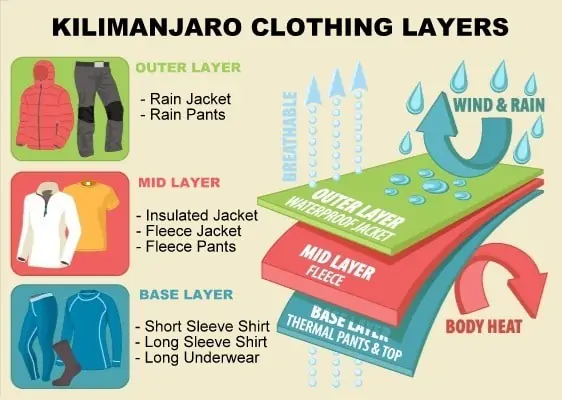 Base Layer: a well fitting, sweat-wicking layer that is worn against the skin.
Base Layer: a well fitting, sweat-wicking layer that is worn against the skin.- Mid Layer: an insulating layer or layers that holds warmth in.
- Outer Layer: a water-proof layer that protects from the elements.
Each of these layering pieces work together to keep you dry, warm and comfortable on Kilimanjaro. All of them are important and must be part of your personal gear when you climb.
We have a recommended gear list which is included below. Be sure to make sure you have the right items before you arrive in Tanzania. Although there are rental gear places, the selection and quality are hit or miss. It’s far better to have these items in place.
Note that we do rent high quality insulated jackets on location.
Suiting Up for the Summit
For most of your trekking, you will be wearing a base layer and maybe a jacket on top and just hiking pants plus underwear on the bottom. This outfit is comfortable for most conditions during the day provided it isn’t raining, particularly windy or cloudy. As long as you are moving, you probably will not be wearing more than this.
When you arrive at camp, as the sun sets, it gets chilly fast. Trade your sun hat for your warm hat. Put on an extra layer or two on top. Try not to be cold while you rest at camp. Bundle up, relax and recover.
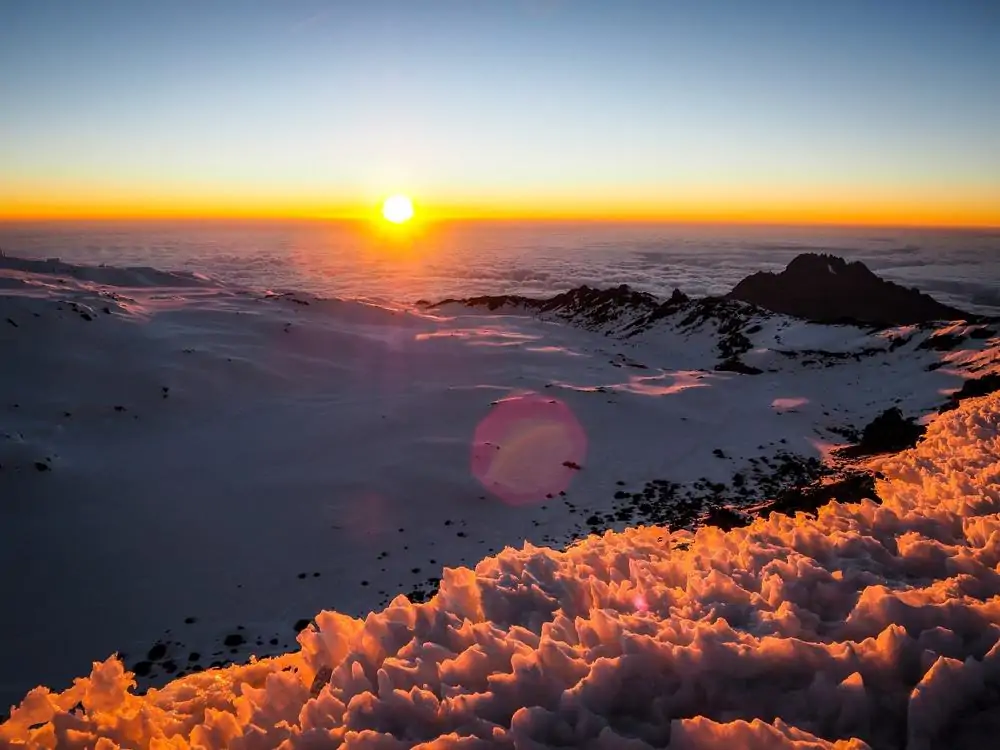
The coldest temperatures you will have to endure is almost always going to be during the summit bid. This section of the climb begins in the wee hours of the morning, around midnight. At this time, the temperature can be below freezing, accompanied by a wind chill factor. Many people are concerned that they will not be warm enough to tolerate the cold for the six to eight hours it takes to reach the top.
Your gear will be put to the test here. We recommend wearing the following items:
- base layer
- fleece jacket
- outer layer
- insulating layer (during extreme cold nights)
- long underwear
- hiking pants
- rain pants
- warm hat
- neck gaiter/scarf/balaclava (during extreme cold nights)
- warm gloves
In your backpack, you can carry an extra top layer for good measure, along with your fleece pants.
When the sun comes up, the temperature will rise accordingly. Shed your layers and put on your sunglasses and sunscreen.
Our Recommended Gear List
The bottom line is to come to Tanzania with the things on our gear list and you will be prepared for anything the mountain throws at you. The gear list may seem excessive, but it is tried and true. We have included items that have served our clients well through the years. Remember that Mount Kilimanjaro is 19,341 feet tall, an extremely high altitude, and experiences extreme weather changes. But with the right gear, it won’t get in the way of your goal.



